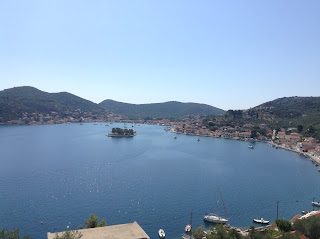We regretfully left the islands behind the next morning, heading on a fast ferry to Patras, mainland Greece. The area we would be travelling in is called the Peloponnese, and many Greeks consider it almost separate from the rest of mainland Greece, with its own cultural identity and a history of strong independence . Considered the birthplace of much of Greek mythology, the Peloponnese literally means the island of Pelops - the tragic hero who became king only to have his entire line cursed - the main cause of his infamy - causing terrible grief and strife for his descendants as it was the main reason (due to the unpleasant ancient concept of tisis: divine retribution)) that the Greeks attributed the misery and tragedy of later heroes including Menelaus, Agamemnon and Orestes.
With such important mythological roots, it was interesting to note the feel of the Peloponnese. It felt ancient, full of ruins and forests and mountains. The Mycenaeans flourished and grew from here during the Bronze Age, becoming one of Europe's first complex and major civilizations, thus it was no surprise that as we headed into the mountains we were soon rewarded with numerous signs pointing to archaeological sites. We followed the first one we saw, and ended up at a beautiful Mycenaean settlement, complete with tombs!
Two lovely Greek caretakers were on site, and seemed very excited to see us, though they spoke no English. There were no other tourists on-site and thus they proceeded to give us a tour of the area, pointing at things, gesticulating their meanings and speaking away at us quite happily in Greek.
It was a really interesting site and seeing their genuine enthusiasm for the place and their excitement to explain it to us was really special. It was interesting to see that unlike later civilizations, the Mycenaeans did not keep their living and dead separate, instead burying infants and children beneath their floors of their houses (you can see a small infant grave within a living space below). Adults however were buried separately, and I found this distinction interesting.

As always with Greece (though Croatia was worse) the road signs were difficult, and though we followed a few more in search of the tantalizing archaeological sites they promised, we didn't find them. As it was nearing lunch time, we decided to hunt for trout farm we knew was on the way somewhere instead. We ended up searching for far too long, however we did eventually find it! Tired and hungry, we sat ourselves down in the peaceful and idyllic paradise by a rushing stream in a little forest.
Dad was finally able to get his trout, washed down with a lovely white wine. However it was dessert I was more interested in. I'm not a big fan of figs but this one had been almost candied, creating an extremely soft, sweet and syrupy dessert. Delicious.
Late in the afternoon we finally arrived at our intended destination for the night, Olympia. We were feeling very tired and decided to go to the archaeological site the next morning to feel refreshed and hopefully avoid the heat of the day. However our evening was not wasted, as we headed to the archaeological museum which had the items found in the area on display.
Am I the only one reminded of childhood modelling clay figurines here?
I especially enjoyed this statue, who was probably piously resting on his hand, but looked more like he was having a nice chat on his cellphone.
After a nice rest at Hotel Kronio, we headed for Olympia. On my last travels in Greece I hadn't managed to get to this famous archaeological site, and so was really looking forward to seeing it. It's main claim to fame is of course as the original site of the Olympic games, however there is so much more to Olympia than that.
The sanctuary of Olympia is a collection of temples dedicated to a plethora of ancient gods including to Hera and Zeus, as well as a number of treasuries from different city states. The site itself is pretty huge, and includes workshops, a stadium and many other buildings. I however, was most interested in the temple of Zeus, built in the 5th century and known for once holding one of the ancient wonders of the world, an enormous ivory and gold statue of said deity.
In its ruined state, toppled pillars lying in the grass looking like dominoes pushed over by some careless giant's hand, it was difficult to imagine how it must have once looked. However seeing the size of just the pillars themselves was staggering and gave an idea to the enormous scale this temple must have been built on.
I could almost imagine the shining statue of Zeus (standing at almost 13 metres tall) seated in his gigantic pillared home, before its eventual destruction. How this architectural masterpiece met its demise is something of a debate, as some records tell that it was carried off to Constantinople, before being destroyed in a great fire. Others claim that it was destroyed along with the temple itself in a fire in 425 AD. Whatever the case (though fire seems definite) no trace or copy of it remains, and we only have ancient descriptions of it to know what it must have once looked like.
Suffering from the heat, we wandered the full extent of the site, before heading for the coast in the hopes of a swim.

Suffering from the heat, we wandered the full extent of the site, before heading for the coast in the hopes of a swim.




































